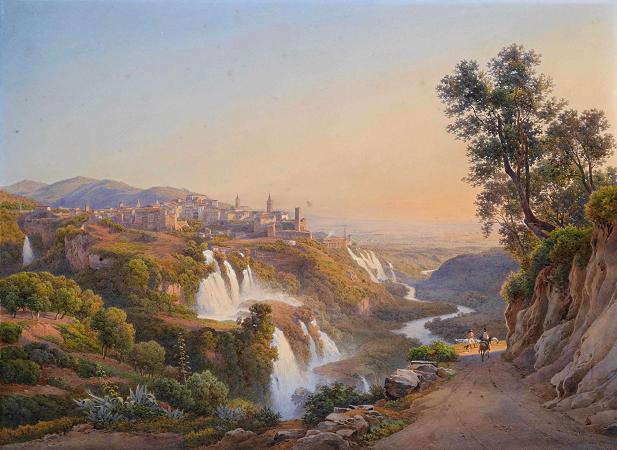Temple of Vesta, Tivoli (c10). The Temple of Vesta is a Roman temple in Tivoli, Italy, dating to the early 1st century BC. Its ruins sit on the acropolis of the city, overlooking the falls of the Aniene that are now included in the Villa Gregoriana. It is not known for certain to whom the temple was dedicated, whether to Hercules, the protecting god of Tibur, or to Albunea, the Tiburtine Sibyl, or to Tiburnus, the eponymous hero of the city, or to Vesta herself, whose more familiar circular peripteral Temple of Vesta is to be seen in the Roman Forum. A rectangular temple stands nearby, equally difficult to attribute, often called the Temple of the Sibyl. The name of the builder or restorer of the Temple of Vesta is Lucius Gellius, memorialized in the inscription on the architrave. The peripteral temple in a variant of the Corinthian order surrounds its circular cella, which is raised on a high brick podium clad in blocks of travertine: the cella has a door and two windows. The ambulacrum that surrounds the cella had eighteen Corinthian columns. The temple's capitals have two rows of acanthus leaves, and its abacus is decorated with oversize fleurons in the form of hibiscus flowers with pronounced spiral pistils. The column flutes have flat tops. The frieze exhibits fruit swags suspended between bucrania. Above each swag is a rosette. The cornice does not have modillions. The comparatively good condition of the temple is owing to its Christianization as a church, Santa Maria della Rotonda. The Christian accretions have already disappeared in the 16th century. Careful measured drawings of the 'Temple of Vesta were published by Antoine Desgodetz who gave elevation and plan as well as carefully rendered details of the carved capitals and the frieze. in the following century both Giuseppe Vasi and Giovanni Battista Piranesi made etchings and engravings of the Temple of Vesta. The Temple of Vesta has provided a model for numerous structures. These range from slavish replicas in landscaped gardens to variants using only some aspects of its detailing. In England, examples include General Pitt River's 1890 Temple of Vesta at Sandroyd School in Wiltshire; William Kent's Temple of Ancient Virtue at Stowe and Sir William Chambers' Temple of Solitude at Kew. Sir John Soane's drawings, which he used as comparative examples in his lectures, are preserved at Sir John Soane's Museum, London. In Northern Ireland, the Mussenden Temple at Downhill was built by Frederick Hervey, 4th Earl of Bristol and Bishop of Derry, in the style of the Temple of Vesta at Tivoli. Indeed, in 1777, he attempted to buy the Temple of Vesta and bring it back to Downhill, but Pope Pius VI would not accede to the proposal. In France, the temple inspired Richard Mique's Temple of Love in his jardin anglo-chinois at the Petit Trianon and Gabriel Davioud's Temple de Sibylle in the Parc des Buttes Chaumont. In Poland, the Temple of the Sibyl in Pulawy was erected by Izabela Czartoryska to designs by the Polish architect Chrystian Piotr Aigner and served as a museum. In northern California, a version of the temple was set as a landscape feature in the English tradition. The Sunol Water Temple was designed in 1910 by California architect Willis Polk for the Spring Valley Water Company to mark the spot in California's Sunol Valley where the waters came together to supply San Francisco.
more...









